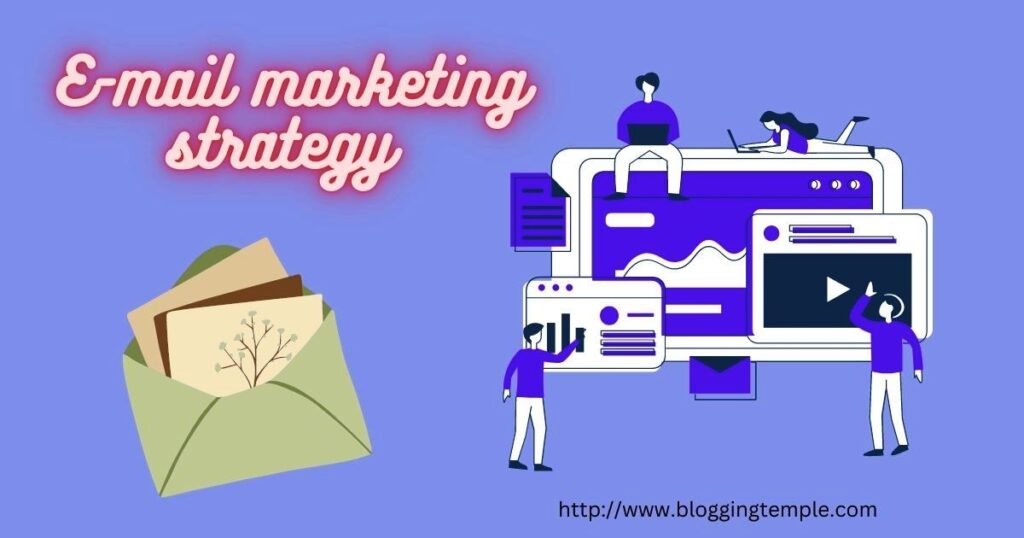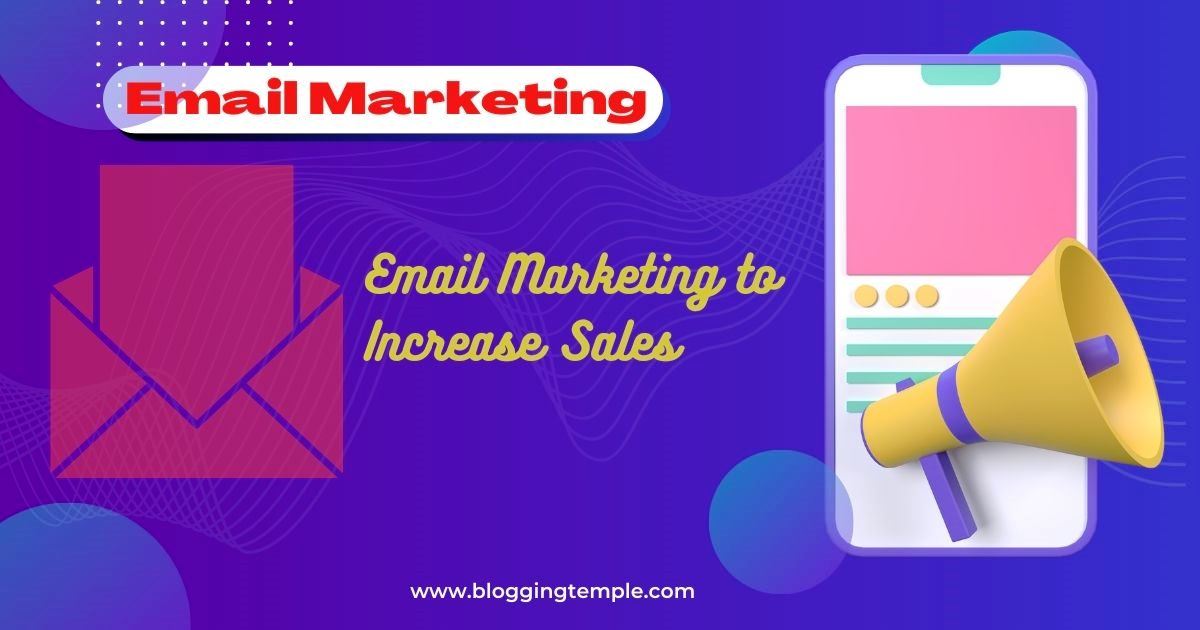In today’s digital age, email marketing remains one of the most reliable and cost-effective methods for businesses to reach their customers. It provides a direct line of communication between businesses and their audience, allowing them to nurture leads, build brand loyalty, and generate sales.
Email marketing is a powerful digital marketing strategy that involves sending commercial messages to a group of people via email. It is an effective way for businesses to connect with their target audience, build relationships, promote products or services, and drive conversions. Email marketing allows businesses to deliver personalized and targeted messages directly to the inbox of potential customers, enabling them to stay engaged and informed.
Table of Contents
Learn About Digital Marketing-https://bloggingtemple.com/what-is-digital-marketing-learn-earn/(opens in a new tab)

Benefits of Email Marketing
Cost-effectiveness and high ROI
Email marketing is highly cost-effective compared to other marketing channels. With minimal expenses involved in designing and sending emails, businesses can reach a large number of recipients at a fraction of the cost of traditional marketing methods. Additionally, email marketing often yields a high return on investment (ROI) due to its ability to generate leads and drive conversions.
Targeted and personalized communication
One of the key advantages of email marketing is its ability to deliver targeted and personalized messages to specific segments of an audience. By segmenting their email list based on demographics, interests, or past interactions, businesses can tailor their messages to resonate with individual recipients, resulting in higher engagement and conversion rates.
Increased brand awareness and customer engagement
Email marketing allows businesses to keep their brand top-of-mind for their subscribers. By regularly sending valuable and informative content, businesses can establish themselves as industry experts, build trust, and foster long-term relationships with their audience. Engaging email campaigns can encourage recipients to interact with the brand, leading to increased website visits, social media engagement, and overall brand awareness.
Email Marketing Strategies
To effectively utilize email marketing, businesses need to implement various strategies that maximize engagement and conversions.
Building an email list
Building a quality email list is crucial for the success of email marketing campaigns. Businesses can collect email addresses through website sign-up forms, social media campaigns, lead magnets, or in-store promotions. It’s essential to obtain permission from subscribers and ensure compliance with data protection regulations.
Creating compelling email content
The content of emails should be compelling, informative, and valuable to the recipients. Whether it’s sharing industry news, providing exclusive offers, or offering helpful tips, businesses should focus on delivering content that resonates with their target audience.
Designing visually appealing emails
Emails with visually appealing designs tend to attract more attention and encourage higher engagement. Using eye-catching images, clear and concise formatting, and a consistent brand identity can enhance the overall visual appeal of emails.
Implementing effective call-to-action (CTA)
Including a clear and persuasive call-to-action (CTA) in emails is essential to drive conversions. The CTA should be prominently displayed and encourage recipients to take specific actions, such as making a purchase, signing up for a webinar, or downloading a resource.
Types of Email Marketing Campaigns
There are various types of email marketing campaigns that businesses can employ based on their goals and target audience.
Welcome emails
Welcome emails are sent to new subscribers to introduce them to the brand and set expectations. It’s an opportunity to provide a warm welcome, share valuable information, and encourage recipients to engage further with the business.
Promotional emails
Promotional emails focus on promoting specific products, services, or offers. These emails often include discounts, limited-time offers, or exclusive deals to entice recipients to make a purchase.
Newsletter emails
Newsletter emails provide subscribers with regular updates, industry news, educational content, and relevant resources. They help businesses stay connected with their audience and position themselves as thought leaders.
Abandoned cart emails
Abandoned cart emails are triggered when a visitor adds items to their cart but doesn’t complete the purchase. These emails aim to remind and persuade recipients to return to the website and complete their purchase.
Re-engagement emails
Re-engagement emails are sent to inactive subscribers to rekindle their interest and encourage them to become active again. These emails often include special offers or personalized content to reignite engagement.
Learn to Improve your knowledge: https://www.binaryeducation.in/
Best Practices for Successful Email Marketing
To maximize the effectiveness of email marketing campaigns, businesses should follow these best practices:
Segmenting your email list
Segmenting your email list based on demographics, preferences, or past interactions allows for targeted and personalized messaging. This increases the relevance of the content and improves engagement and conversion rates.
A/B testing subject lines and content
Testing different subject lines, email designs, and content variations can help identify what resonates best with the audience. A/B testing allows businesses to optimize their emails and improve open rates, click-through rates, and overall campaign performance.
Optimizing for mobile devices
With the increasing use of mobile devices, it’s crucial to ensure that emails are mobile-friendly and display correctly on smaller screens. Responsive design and testing emails on different devices and email clients are essential for a seamless user experience.
Monitoring and analyzing email performance
Regularly monitoring email performance metrics such as open rates, click-through rates, conversion rates, and unsubscribe rates provides valuable insights. Analyzing these metrics helps identify areas for improvement and refine email marketing strategies.

Email Marketing Tools and Platforms
Several email marketing tools and platforms can simplify the process of creating, managing, and analyzing email campaigns. Some popular options include:
- Mailchimp
- Constant Contact
- AWeber
- GetResponse
- SendinBlue
These tools offer features such as email templates, contact management, automation workflows, analytics, and integration with other marketing platforms, making it easier for businesses to execute successful email marketing campaigns.
Email Marketing Metrics to Track
Tracking email marketing metrics is essential for measuring the success of campaigns and making data-driven improvements. Some key metrics to monitor include:
- Open rate: The percentage of recipients who open the email.
- Click-through rate (CTR): The percentage of recipients who click on links within the email.
- Conversion rate: The percentage of recipients who complete the desired action, such as making a purchase or filling out a form.
- Bounce rate: The percentage of emails that were not delivered to the recipient’s inbox.
- Unsubscribe rate: The percentage of recipients who opt out of receiving future emails.
By analyzing these metrics, businesses can identify areas of improvement, optimize their campaigns, and achieve better results.
Common Challenges in Email Marketing
While email marketing offers numerous benefits, businesses may face certain challenges. Some common challenges include:
Deliverability issues
Email deliverability refers to the ability of emails to reach recipients’ inboxes without being filtered as spam. Issues with deliverability can occur due to various factors, including the quality of the email list, sender reputation, content quality, and compliance with anti-spam regulations. It’s important to follow best practices to ensure high deliverability rates.
Spam filters and email regulations
To combat spam, email service providers employ advanced spam filters that can sometimes mistakenly classify legitimate emails as spam. Businesses need to be mindful of email regulations, such as the CAN-SPAM Act, and adhere to guidelines to avoid legal issues and maintain a positive sender reputation.
List hygiene and management
Maintaining a clean and engaged email list is crucial for the success of email marketing campaigns. Regularly cleaning the list by removing inactive subscribers, managing unsubscribes, and handling bounce-backs helps improve engagement rates and deliverability.
Design and coding challenges
Designing visually appealing emails that display correctly across different email clients and devices can be a challenge. It’s important to use responsive email templates, test emails thoroughly, and ensure compatibility to provide a seamless experience for recipients.
The Future of Email Marketing
As technology continues to advance, email marketing is evolving to offer even more personalized and engaging experiences. Some trends shaping the future of email marketing include:
AI-powered personalization
Artificial intelligence (AI) is being used to analyze customer data and deliver highly personalized email content. AI algorithms can segment audiences, recommend products based on individual preferences, and automate email personalization, resulting in more relevant and engaging emails.
Interactive and dynamic emails
Interactive and dynamic emails go beyond static content by incorporating elements such as interactive surveys, quizzes, product carousels, and live content. These types of emails enhance user engagement, encourage interaction, and provide a more immersive experience.
Integration with other marketing channels
Email marketing is becoming more integrated with other marketing channels, such as social media, content marketing, and automation workflows. This integration allows for cohesive and targeted campaigns that leverage the strengths of each channel to maximize results.
Conclusion
Email marketing continues to be a powerful tool in the digital marketing landscape. Its cost-effectiveness, personalization capabilities, and direct communication make it a valuable strategy for businesses of all sizes. By implementing effective email marketing strategies, businesses can nurture relationships, drive conversions, and achieve long-term success.
FAQs
How often should I send emails to my subscribers?
The frequency of sending emails depends on several factors, including your industry, audience preferences, and the type of content you are delivering. It’s important to maintain a consistent schedule without overwhelming your subscribers. Test different frequencies and monitor engagement metrics to determine the optimal sending frequency for your audience.
What are the key elements of a successful email campaign?
A successful email campaign incorporates several key elements. These include a compelling subject line, personalized content, clear and visually appealing design, a strong call-to-action, mobile responsiveness, and relevant targeting. By focusing on these elements, you can maximize the effectiveness of your email campaigns.
Can I use purchased email lists for my campaigns?
It is generally not recommended to use purchased email lists for your campaigns. These lists often consist of unengaged or uninterested recipients, which can result in low open rates, high bounce rates, and damage to your sender reputation. It is best to build your email list organically, with subscribers who have willingly opted in to receive communications from your business.
How do I measure the success of my email marketing efforts?
To measure the success of your email marketing efforts, you should track relevant metrics such as open rates, click-through rates, conversion rates, bounce rates, and unsubscribe rates. Additionally, monitoring key performance indicators (KPIs) specific to your campaign goals, such as sales, lead generation, or website traffic, can provide valuable insights into the overall effectiveness of your email marketing strategy.
Is email marketing still relevant in the age of social media?
Absolutely! Despite the rise of social media, email marketing remains a vital and effective channel for businesses. While social media platforms offer an avenue for engagement, email provides a more direct and personalized form of communication. It allows businesses to reach their audience directly in their inbox, deliver targeted messages, and build lasting relationships. Moreover, email marketing and social media can work together synergistically to enhance overall marketing efforts.


0 thoughts on “What is Email Marketing in Digital Marketing | Full Tutorial with Ease in About 2000 Words.”